What Is Payroll Accounting in Singapore: A Comprehensive Guide
- Published: 1 October 2024
- 13 min read
- Running a Business, Tax & GST


Heather Cameron
Author
From expert guidance and helpful accounting tips to insights on the latest trends in fintech, Heather is here to empower entrepreneurs and small business owners in Singapore with great content. With a background in digital marketing spanning eight years, she has experience writing for various industries and audiences. As Osome’s copywriter, she’s here to inform and inspire our readers with great storytelling.

John Yap
Reviewer
John Yap, our Head of the Accounting Team in Singapore, brings over a decade of expertise in SFRS, corporate tax, and GST compliance. As a key blog reviewer, John ensures our accounting content is accurate and relevant, transforming complex concepts into actionable advice. With John's meticulous oversight, you can trust that our blog provides reliable and up-to-date information to help you navigate the intricacies of financial management and compliance in Singapore.
Payroll accounting manages employee salaries, deductions, and taxes to ensure accurate and timely payments within each pay period. It is crucial for maintaining compliance and building trust between employers and employees. In this article, we will cover the key components, setup process, and benefits of having an effective payroll accounting process.
Key Takeaways
- Payroll accounting is crucial for tracking employee expenses, ensuring accurate payments, and maintaining legal compliance for companies in Singapore.
- Key components of payroll accounting include employee compensation, payroll taxes, and payroll deduction, each playing a vital role in accurate payroll management.
- Payroll accounting software can significantly enhance efficiency, reduce errors, and ensure compliance with regulatory obligations through automation and integrated features. It also helps payroll accountants to manage and calculate payroll more effectively.
What Is Payroll Accounting
Payroll accounting primarily tracks and monitors labour costs and ensures that all financial transactions related to employee compensation are accurately recorded. It involves calculating salaries, tracking work hours, and issuing employee paychecks while complying with legal obligations. Payroll accountants play a vital role in this process, working closely with HR teams to manage payroll responsibilities and ensure timely employee payment.
Osome offers a streamlined solution by automating payroll accounting, ensuring compliance, accuracy, and on-time payments within each pay period so businesses can focus on growth instead of administrative tasks. Feel free to contact us today!
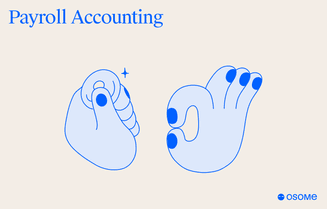
Accurate payrolls help foster trust between the employer and employees and ensure legal compliance. This process includes maintaining meticulous payroll records, which are essential for resolving disputes and adhering to regulatory requirements.
With the advent of automated systems and software, businesses can optimise their PAYROLL processes, significantly reducing errors and enhancing efficiency. Payroll accounting covers recording, filing, and paying employees, making it a cornerstone of effective financial management.
Key Components of Payroll Accounting
Payroll accounting has several key components: employee compensation, payroll taxes, and payroll deduction. Each element plays a critical role in the payroll accounting process, ensuring that employee costs are accurately tracked while meeting compliances. Payroll accounting aids in budgeting and financial planning by providing insights into employee compensation.
Using accounting software ensures accurate and up-to-date records, enhancing financial process efficiency. This integration supports better financial management and aids in strategic decision-making.
Let’s delve deeper into each of these components to understand their significance.
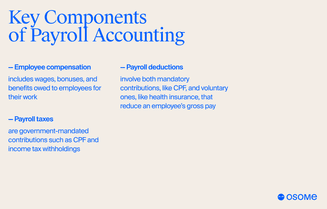
Employee compensation
Employee compensation encompasses various forms, including salaries, bonuses, additional allowances and employee commissions, which are the gross earnings of an employee. Gross earnings refer to the total amount earned by an employee before any deductions are made.
Creating precise payroll journal entries captures all financial transactions accurately.
Payroll taxes
In Singapore, employers are required to contribute 17% of employees’ monthly wages to the Central Provident Fund (CPF), capped currently at SGD 1,156 per month (2024: SGD 1,156; 2025: SGD 1,258; 2026: SGD 1,360). Additionally, the Skill Development Levy (SDL) is another mandatory contribution, calculated at 0.25% of monthly wages with a specific minimum and maximum amounting to SGD 11.25. These contributions are critical for compliance with Singapore’s regulatory framework.
Unlike many other countries, Singapore does not impose payroll tax withholding. Instead, employees are responsible for filing state income taxes individually while employers manage other statutory obligations, such as the foreign worker levy and the newly launched SkillsFuture Jobseeker Support scheme, whose contribution operates similarly to unemployment taxes in other countries.
Payroll deductions
Payroll deduction refers to the amount removed from employee salary before issuing a payout. These deductions can be categorised into mandatory and voluntary types. Mandatory deductions include contributions to the Central Provident Fund (CPF), which covers retirement, healthcare, and housing needs. Voluntary deductions may include contributions to additional health insurance or savings plans. CPF contributions help reduce an employee’s taxable income, potentially lowering tax liabilities for the employee.
Payroll deductions are calculated by determining gross pay, subtracting CPF contributions, withholding tax (if applicable), and then deducting any post-tax items to arrive at net pay. Errors in this calculation can result in serious consequences, such as penalties from authorities like IRAS or delayed payouts.
Types of Payroll Accounting Entries
In Singapore, payroll accounting involves several types of entries that ensure proper tracking of employee wages, taxes, and statutory contributions. These entries are crucial for maintaining accurate financial records and ensuring compliance with legal requirements. The primary types of payroll accounting entries include gross salary, deductions, and employer CPF contributions.
Each type of entry serves a specific purpose within the payroll accounting process. Gross salary entries capture the total earnings of employees before any deductions. Deductions entries account for mandatory and voluntary deductions from employees’ salaries. Employer CPF contributions represent the employer’s share of contributions to the Central Provident Fund.
Let’s explore each type in detail.
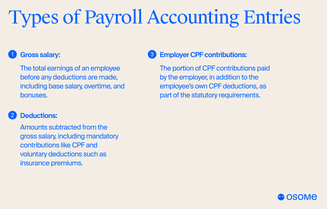
Gross salary
Gross salary refers to the total earnings of an employee before any deductions are made. This includes basic pay, overtime, allowances and bonuses.
Accurate recording of gross salary is essential for calculating payroll expenses and ensuring that employees receive their correct compensation.
Deductions
Payroll deductions include CPF contributions, income tax withholdings, and other withholdings such as insurance or loan repayments. Properly recording these deductions is crucial for compliance purposes, ensuring that net pay in each pay period is accurately calculated. Your employee's net pay is its gross salary minus all necessary deductions.
Employer CPF contributions
Employer CPF contributions are recorded as an additional payroll expense. These contributions are mandatory and must be accurately calculated and recorded to ensure compliance with Singapore’s regulatory requirements.
Setting Up Your Payroll Accounting in Singapore
Setting up payroll accounting in Singapore involves several essential steps to ensure compliance and efficiency. The process begins with registering your business, followed by registering as an employer with the CPF Board, and finally, classifying your employees accurately. Each of these steps is crucial for setting up a robust payroll system that meets all regulatory requirements.
Establishing your accounting system ensures compliance, streamlines the process, reduces errors, and enhances efficiency. Let’s break down these steps in detail.
Register your business
To set up payroll accounting in Singapore, the first step is to register your business with the Accounting and Corporate Regulatory Authority (ACRA). You must appoint at least one local director and one company secretary. Proper registration is essential for legal compliance and for establishing a foundation for your payroll system.
Register as an employer
Once your business is registered, the next step is to register as an employer with the CPF Board using the company's CorpPass. This registration ensures that you meet your mandatory contribution obligations to the Central Provident Fund. Compliance with CPF requirements is critical for avoiding legal issues and ensuring your employees receive their entitlements.
Classify employees
Accurate employee classification is essential for determining the correct deductions and benefits. In Singapore, employees are typically categorised into full-time, part-time, exempt, non-exempt, permanent, temporary, and independent contractors. Full-time employees usually work a set number of hours weekly and are eligible for benefits, while part-time employees work fewer hours and may have limited benefits.
Misclassifying employees can lead to significant legal and financial consequences for businesses in Singapore. Therefore, gathering comprehensive employee information, including salary, leave, and hours worked, is crucial to ensure accurate payroll classification. Correct classification affects payroll taxes, employee rights, and the benefits employers must provide.
The Payroll Process Workflow
The payroll process workflow involves a series of steps to ensure timely and accurate employee compensation. It starts with collecting employee hours and ensuring compliance with labour regulations, followed by calculating contributions and taxes, and finally, disbursing payments. This workflow is designed to streamline the payroll process and minimise errors.
Understanding the payroll process workflow ensures that all payroll tasks are completed accurately and on time, enhancing employee satisfaction and maintaining compliance with legal requirements. Let’s explore the key steps in this workflow.
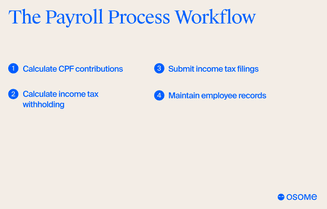
Calculate CPF contributions
Calculating CPF contributions is a critical step in the payroll process. Employers must calculate these contributions based on the employee’s wages and prevailing CPF rates. Utilising online CPF calculators can simplify this process, ensuring accurate calculations based on employees’ monthly salaries. Staying informed about changing CPF contribution rates and salary ceilings is crucial for payroll accuracy.
The total CPF contributions are calculated based on an employee’s ordinary and additional wages, applying the relevant contribution rates and rounding off to the nearest dollar. Employers can recover the employee’s share of CPF contributions from their wages for the month, with specific rounding rules applied to the calculations.
Calculate withholding taxes
Withholding tax is another critical aspect of the payroll process. In Singapore, withholding tax is calculated based on flat tax rates (15% to 22%), which vary according to the employee’s type of income. Employers must consider both resident and non-resident tax rates when calculating withholding tax.
Taxable income for employees includes all employment-related earnings, such as wages, bonuses, and allowances. Employers must prepare an annual income tax report (IR8A) for each employee, due by February 28 of the following year.
Calculating income tax and withholding tax accurately is essential to avoid tax penalties and ensure compliance with legal requirements.
Submit income tax filings
Submitting income tax filings is a mandatory requirement for employers in Singapore. Employers must submit the IR8A form to the Inland Revenue Authority of Singapore (IRAS) by February 28 each year.
Accurately completing and submitting income tax forms by deadlines avoids tax penalties and ensures compliance.
Maintain employee records
Maintaining employee records ensures compliance and effective management. Employers must keep records of employee salaries, CPF contributions, and taxes for at least five years. Regularly updating these records to reflect any changes in compensation or employment status is crucial for accurate payrolls.
Well-organised employee records are also important for reference in audits and compliance reviews.
Managing Payroll Expenses
It is crucial to manage payroll expenses effectively if you want to gain insights into your company's labour costs and their impact on your overall cash flow. Payroll expenses include employee wages, salaries, benefits, payroll taxes, and other contributions. Accurate tracking of these expenses helps businesses make informed hiring decisions and assess their financial health.
Payroll systems can tag expenses and run detailed reports to provide a comprehensive view of total employee costs. Proper management of payroll expenses impacts net income or loss and affects profit analysis. Companies can record payroll expenses weekly, biweekly, or monthly, depending on their systems.
Tracking payroll costs
Tracking payroll costs involves considering all expenses incurred to process payroll, including direct compensation, indirect compensation, withholding taxes, and payroll liabilities. Using payroll software can significantly reduce errors and automate calculations, making the tracking and management of payroll expenses much easier. You should also take into account accrued wages, which are wages that have not yet happened but will be paid out in the future.
Ensuring that payroll liabilities are paid to various agencies on time and managing the accrual of payroll expenses are crucial aspects of tracking payroll costs.
Payroll liabilities vs. payroll expenses
Payroll liabilities refer to money that you owe and have not paid yet, such as unpaid amounts owed to agencies like CPF and accrued wages (accrued liabilities). Payroll expenses refer to the costs associated with paying your employees. These expenses are paid and reset on a monthly basis.
Proper management of payroll liabilities requires adherence to due dates and remittance processes to avoid legal and financial penalties.
Benefits of Using Payroll Accounting Software
Accounting software comes with significant benefits, including organised payroll documents, automated tasks, and reduced calculation errors. Automation ensures accurate payroll accounting by minimising human errors and streamlining the payroll process.
Moreover, payroll software often includes features that simplify payroll functions, such as tax and deduction calculations and compliance support. These features are particularly beneficial for businesses with complex payroll needs, as they enhance management agility and employee satisfaction.

Let’s delve into the specific benefits of using accounting software.
Reducing errors and automating calculations
One of the primary benefits of using payroll software is the reduction of errors through automation. Payroll software can automatically transfer hours worked from timesheet systems, simplifying payroll calculations and ensuring accurate payroll accounting. This automation minimises the risk of human errors, leading to more accurate and timely payroll processing.
Integration with financial systems
Integrating payroll software with other financial systems allows for more streamlined operations and minimises discrepancies in financial records. This integration enhances the efficiency of financial transactions and ensures that all payroll accounting entries are accurately recorded, contributing to better financial management and decision-making.
Employee self-service features
Employee self-service features in payroll software empower employees to manage their own payroll information, improving transparency and convenience. An online payroll solution can provide employees with access to their payroll information online, directly connecting to employee bank accounts, enhancing engagement and satisfaction with the payroll process.
Choosing the Right Payroll Solution
Choosing the right tool for payroll is essential for compliance, efficiency, and effective employee management. When selecting payroll software, it’s crucial to consider your company’s size, budget constraints, and the resources available internally. Evaluating payroll software options based on functionality, cost, user-friendliness, and support services ensures that the payroll solution fits your company's needs.
Top payroll services offer comprehensive features such as automated tax calculations, direct deposit options, and compliance support. These services can significantly enhance payroll management, making the process more efficient and reducing the risk of payroll errors.
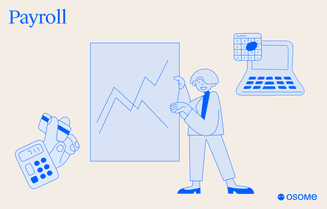
Let’s explore key factors for evaluating payroll software options and highlight some top payroll services.
Evaluating payroll software options
When evaluating software options, it’s important to consider essential features like:
- Automatic statutory deduction submission
- Flexible benefit plans
- Seamless ERP integrations
- Automated calculations
These features help streamline payroll tasks, enhance accuracy, and fit the unique needs of the business.
Your company’s size, budget constraints, and available resources are all important aspects to consider when choosing software for payroll.
User-friendly and efficient payroll software contributes to successful payroll processing. The right solution should improve payroll management, overall employee satisfaction and compliance with legal requirements.
Top Payroll Services
Several top payroll service providers offer specialised solutions for businesses in Singapore. Osome provides cost-effective payroll solutions with a team of certified accountants specialising in payroll management.
Challenges of Manual Payroll Management
Manual payroll presents numerous challenges, including the risk of human errors, significant financial discrepancies, and employee dissatisfaction. Major issues with manual processes include data-entry errors, lack of control over funds, malpractice, and leakage. Handling sensitive employee information manually raises security concerns, making data protection critical to maintaining employee trust.
Implementing a payroll system helps businesses manage legal responsibilities and reduces the risk of IRAS penalties. Managing various employee benefits and deductions manually increases the risk of errors, impacting employee satisfaction.
Recording payroll entries manually is labour-intensive and can lead to delays in salary payments, significantly lowering employee morale and productivity. The same goes for manual payments, which are far less reliable than automated payroll schedules.
Summary
In summary, payroll accounting in Singapore involves various critical components, including employee compensation, payroll taxes, and deductions. Setting up and managing payroll accounting effectively requires understanding the payroll process workflow, managing payroll expenses, and leveraging accounting software. Accurate payroll accounting ensures compliance, enhances financial management, and improves employee satisfaction.
By transitioning from manual management to automated payroll workflows, businesses can optimise their payroll processes, reduce errors, and streamline operations. With the insights provided in this guide, you are now equipped to transform your payroll accounting practices and achieve greater operational excellence.






